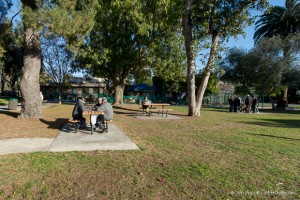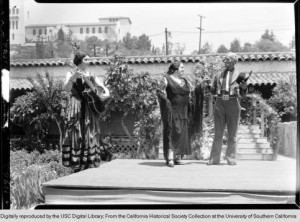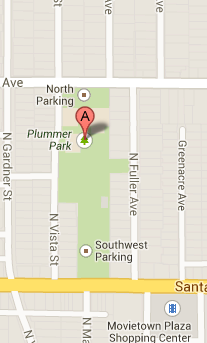An element in the continuing debate over whether to preserve Great Hall / Long Hall and other aspects of Plummer Park is its historic and cultural significance. Protect Plummer Park, a citizens group advocating for a sensitive rehabilitation and restoration of the existing park, successfully lobbied for inclusion of Great Hall / Long Hall (Plummer Park Community Clubhouse) on the National Register of Historic Places. Here WEHOville presents an excerpt (edited for space considerations) of the explanation of the park’s cultural and historical significance written by Jen Dunbar of the West Hollywood Preservation Alliance for presentation to the National Register.

The Plummer Park Community Clubhouse provides an excellent example of the regional impact of Works Progress Administration‘s funding in Los Angeles County.
Across the country, the WPA program was administered by a partnership between the federal government and “sponsors,” who tended to be local and regional governments that controlled and oversaw a project at a local level. Sponsors could determine the style, materials and construction type of their particular projects. This allowed for schools, post offices, community and recreational centers and other such public facilities to be built as well as for upgrades to transportation and utilities infrastructure.
The social and economic conditions of Los Angeles County (in the 1930s) made it a prime candidate for such WPA projects. The county saw a substantial population increase during the Great Depression because of an influx of people looking for jobs in the entertainment industry, health services and agricultural and oil resources. As the population swelled, so did pressure on infrastructure, transportation, housing, and social services. Los Angeles had a serious problem with unemployment, second in the country only to New York, of white collar workers (often referred to as “soiled collar workers”).
The Los Angeles County Board of Supervisors seized every opportunity to implement projects through WPA funding, seeing them as an opportunity to help the unemployed by giving them jobs and “getting them off the dole.” County WPA projects from 1935 to 1943 ranged from street and infrastructure improvements, land use planning and documentation, parks and recreation facility improvements, development of public school curricula and public building construction. This was in addition to the WPA Federal One program focusing on art, writing and music, which also flourished in Los Angeles County.
The creation and development of recreational facilities accounted for a considerable amount of money spent on county WPA projects. A county Department of Recreations Camps and Playgrounds survey in 1937 found that Los Angeles had 19,051 acres devoted to recreation and over two million dollars in federal funding allocated to recreation projects. One reason for the focus on recreation was that it was seen as a formal field of study and a way to create jobs. From 1933 to 1937, the Department of Recreations Camps and Playgrounds oversaw a massive training program for unemployed men and women in recreation supervision to address a rising public interest in recreational activities. With county residents’ enthusiastic interest in outdoor recreation, there also was a need for more parks and facilities as well as operators and administrators.
As a result, the county Regional Planning Commission, which reported to the Board of Supervisors, sought to turn “every piece of odd area in the county, whatever its size; every bit of unutilized land isolated by street intersections” into a recreational center, picnic ground, or park, according to a 1939 story in the Los Angeles Times.

In the Spring of 1937, the Los Angeles County Board of Supervisors approved a plan to lease, with an option to purchase, land from Eugenio “Captain” Plummer to increase its public parkland holdings and relieve pressure for much needed community gathering space. The four acre park was the last remnant of undeveloped land amidst a growing residential community on its north, east, and west borders, and the busy retail and light industrial thoroughfare of Santa Monica Boulevard on the south border. Plummer sold the property to the County later that year to avoid foreclosure.
Even prior to the county’s purchase, the land was considered a “unique” park. In 1877, Plummer was deeded the land from Senora Francisca Perez, who had occupied it since 1869. Previous to Senora Perez, the land was part of the original Rancho LaBrea tract. The original parcel consisted of one hundred and sixty acres and included the hillside where the Hollywood Bowl now sits. Plummer built a house on the land in 1878 and lived in the house with his mother until her death, and later his wife, until her death. Plummer and his property were regarded as the social center of the county during the area’s early settlement years. Captain Plummer, a charismatic environmentalist and a pioneer of Los Angeles who had lived on the land since childhood, fueled a romantic and nostalgic imagery of early colonial life in Southern California. His addition of numerous rare plants and trees to the land contributed to the distinctiveness of its natural park setting.

As a condition to selling the last remaining acres of his property to Los Angeles County. Plummer was allowed to live in his house until his death at 91 in 1943. At the dedication of the Clubhouse, Plummer was designated as the historical guide for the park. Under the direction Recreation Camps and Playgrounds Superintendent James K. Reid the park was specifically set up to remain in its “romantic” state.
In the fall of 1937, $720,000 in federal funds were allocated to various projects throughout Los Angeles County, with Plummer Park receiving $22,000. In total, the Plummer Park building project cost $60,000 when completed. (By the Bureau of Labor’s Statistics CPI inflation calculator, that would be close to $1 million in today’s dollars). It consisted of a new community “clubhouse” that would provide a much needed meeting space for various recreational and service clubs, activities and social events for local residents.
Because the county had direct control over the project as its sponsor, it could decide the style of the building. Edward C.N. Brett, the county’s chief architect, decided it should reflect a prevailing public sentiment for “Old California.” The single story building with its low gabled tile roof, sited in the center of the park amid lush plants and trees, complemented the quaint single and multifamily homes lining the streets around the park.
Modest details such as the exterior shutters, casement windows, an interior rounded corner fireplace, thick decorative scrolled ceiling beams and flagstone- patterned concrete pavers added to the architectural charm.
The craftsmanship, plan and details of the Community Clubhouse reflected the inspiration and simplicity of the colonial missions and adobes built throughout California, characteristics of Spanish Colonial Revival style. Its Spanish Colonial Revival style also distinguished it from the WPA-era Modern style of many buildings found throughout Los Angeles.
The clubhouse’s use as a gathering center married well with the courtyard configuration often employed by buildings of this style. As these building types were often a response to the environment, spaces needing natural light were placed along the east-west axis, while those that did not ran along a north-south axis. Long Hall, intended as a reading room, sat along the east-west axis, while Great Hall, an entertainment space, followed the north-south axis. The low flat ceiling of Long Hall with its thick scrolled beams marching down the length of the room recall the Romanesque style nave, a feature often found in the missions.
Great Hall, with its stage and rustic, open trussed ceiling was a performance space to replace the “Old Rancho Barn Theater.” The courtyard provided a gathering space for barbeques and picnics, with shaded spaces under the surrounding arcade. Long Hall provided a space to house exhibits. Hernando G. Villa, who was known for his illustrations for the 1932 Olympics and for creating the “chief” emblem for the Santa Fe Railroad, as well as paintings of early California scenes, exhibited his work at the Clubhouse in 1939. That same year, the California Bear Flag was presented to park director Florence Lewis Scott and raised over the building as a symbol of “our endeavor to carry forward the charm and spirit of Old California to enrich our present day lives.”
From 1938 to 1984, the park and the clubhouse remained under the supervision of Los Angeles County Parks and Recreation. In 1984, Plummer Park and all of its structures were turned over to the City of West Hollywood with its incorporation. The Clubhouse operated continuously as a gathering space for local organizations and, until recently, also housed the 75-year-old Los Angeles Audubon Society. ACT-UP/LA sees the Community Center as part of its history. This AIDS activist organization held its weekly meetings there for nine years and supports its designation as a historical resource both for its previous and recent historical association.

It is so good to see reasonable voices finally weighing in on this issue. Brin on the wrecking ball!
The first meeting of the West Hollywood Incorporation Committee took place at my home in the Spring of 1983. I believe John Heilman and I are the only surviving members. I hope the memory of our leader, Ron Stone, has not been entirely forgotten. He was my friend. I was the Committee’s Director of Information. I attended every Committee meeting, and worked nearly full time on incorporation issues during the 18 months before the election. The Committee never met in Plummer Park. There was a nominal charge for the use of the park buildings and we had no funds. I… Read more »
Rudolf – my thoughts exactly vis a vis a criminal law attorney. Unless it’s the Innocence Project and to some degree the ACLU (of which I am a member) – I sorta shy away from them.
And Larry – good one – they brings a sad picture to the word ducks – but they are lame ducks indeed. Once they leave the council they can move outta town.
No, actually we don’t all have the same goals in mind for Plummer Park. If the park had begun as approved and scheduled two years ago. We be looking a completed upgraded Plummer Park. No Great Hall/Long Hall and a Great Lawn. Since the plan was stalled and the Redevelopment Agency funds fall out, the community has been subjected to a one-sided filibuster at every televised meeting the City has put forth. This, after many, many residents planned, talked implanted a Phase 1 plan for Plummer Park and was approved. Today, its time to move this six+ year delay forward… Read more »
When it comes to what is best for West Hollywood, Plummer Park and land use, I do whole-heartedly support the judgment of council members Duran, Heilman, Land and Prang in calling for the removal of Great Hall/Long Hall in Plummer Park. I will defer to their judgment when it comes to the question of what is best for West Hollywood and ALL its residents, visitors, young and old. West Hollywood is a fiscally sound and growing urban city. I think the local leaders know far better than the state or the federal government on what is the best action to… Read more »
Thank you Jen Dunbar for doing this work. The fact that these buildings are of national historic and architectural significance is not up for discussion. John “People Make History, Buildings Don’t” Duran would have demolished Constitution Hall with his brilliant logic. When a criminal defense attorney has “a vision” for Plummer Park we should all be scared. “90046” (you seem to be running out of aliases, what’s wrong with “WehoGuy” or “Wehoan Fed Up with the NIMBYs”?), your comment wreaks of more ignorance and idiocy than any one person could possibly address. Let me just say that i would love… Read more »
When it comes to what is best for West Hollywood, Plummer Park and land use, I do whole-heartedly support the judgment of council members Duran, Heilman, Land and Prang in calling for the removal of Great Hall/Long Hall in Plummer Park. I will defer to their judgment when it comes to the question of what is best for West Hollywood and ALL its residents, visitors, young and old. West Hollywood is a fiscally sound and growing urban city. I think the local leaders know far better than the state or the federal government on what is the best action to… Read more »
FRIENDS, we all have the same goals in mind for Plummer Park, a peaceful place for all to enjoy. There is such a divide over how to get to that peaceful place that we need to ask the council to table the demolition and trust the community to decide. Measure P : Plummer Park – Let the People decide! I hope D’amico can bring a new item to the agenda, a measure to let the community decide on the fate of Plummer Park. Im sure that Duran running for supervisor will not vote against the people deciding and Heilman and… Read more »
@snarkygal, I would agree with you that the old growth trees should be preserved as they serve a good purpose and are very hard to replicate. I would understand anxiety of removing all of them as was originally planned with the sci-fi renovation. However, the buildings, while maybe nostalgic, are just not special enough to warrant someone chaining themselves to the threshold to protect it from demolition. They look like double wide trailers with adobe shingles. Underutilized space which could be freed up.
@ WeHoGuy ( another anonymous individual) It must be satisfying in a childish sort of way to denigrate and belittle the informative and well-informed opinion presented by Jen Dunbar who is a degreed architect specializing in historic preservation. Bet you shook down grade school kids for their lunch money too. Same mindset. She did readers a valuable service today. Today our former Veep, Dick Cheney – defended his vote against freeing Mandela from prison and added that “he had mellowed since he left prison”. Right Dick, and built a new nation and created a new way to perceive of justice… Read more »
I wouldn’t walk through this park at 10:00 p.m. if you paid me. It is not cultural or historic spot but rather one riddled with crime, drugs, sex, and urine. It is so dark at this park that I’m amazed there aren’t more attacks. There is no arguing with the same crazy 10 people that constantly talk on this website. The only fact that we need to know is that Great Hall/Long Hall is going down and a new and more beautiful park and space will go up in its place. I can’t wait to see all these residents who… Read more »
@90069 – you have your park. Let the people on the East Side have a say in the park on their side of town. Many of us love Great Hall/Long Hall and want it to be repurposed and used. We don’t want a sterile park like West Hollywood Park. We would rather keep our buildings and OLD GROWTH TREES. Who needs a big lawn. Many of the users of OUR park are elderly and sit under the shade of the trees and play cards. The Council doesn’t care about that. The local artists would love to use Great Hall/Long Hall… Read more »
These buildings did their job 70+ years ago when the country was in depression and the sparcely populated Sherman was able to build a single story shack. Now in 2013 the economy is still weak and we could use the constrcution jobs to create a new park that meets the needs of a new city that is radically different than I’m sure anyone from 1940 could imagine.
Let’s take our pictures now and let the bulldozers come ASAP. The building from an architecual standpoint is hideous and from a utilization standpoint is ill equiped for the modern era.